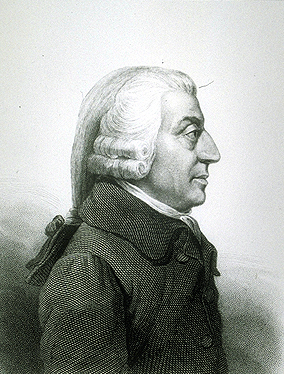‘One man draws out the wire, another straights it, a third cuts it, a fourth points it, a fifth grinds it at the top for receiving the head; to make the head requires two or three distinct operations; to put it on, is a peculiar business, to whiten the pins is another; it is even a trade by itself to put them into the paper; and the important business of making a pin is, in this manner, divided into about eighteen distinct operations, which, in some manufactories, are all performed by distinct hands’.
Adam Smith’s description of the pin factory, with which he begins The Wealth of Nations, introduces the fundamental economic concept of the division of labour. His account is perhaps the most famous description of an industrial process in the history of economic thought.
The economic historian Sir John Clapham chided Smith for his use of what Smith himself conceded was “a very trifling manufacture”. He wrote “It is a pity that Adam Smith did not go a few miles from Kirkcaldy to the Carron works, to see them turning and boring their cannonades, instead of to his silly pin factory which was only a factory in the old sense of the word” (Clapham 1913, p. 401).
Clapham was taking some liberties with the facts. Smith could not have seen the boring of a carronade (not cannonade) since the Carron works only began their production after the publication of The Wealth of Nations. The carronade was a short muzzled cannon named for the factory which manufactured them – or strictly for the river on which the Carron works were sited. Napoleon would blame the defeat of his fleet at Trafalgar on the carronade. ’The English have been the first to use carronades, and everywhere they have done us great harm’ he wrote.
The Carron works were described by one visitor of the time as the largest industrial premises in Europe (and if so, in the world). Another visitor, the Scottish poet Robert Burns, was less impressed:
‘We cam na here to view your works, In hopes to be mair wise, But only, lest we gang to hell, It may be nae surprise.” (We did not come to see your factory in the hope of acquiring greater wisdom, but only so that if we are destined for hell it will not come as a surprise.’)
Burns’ disappointment was compounded by his failure to gain admission: ”But when we tirl’d at your door, Your porter dought na hear us; Sae may, shou’d we to hell’s yetts come, Your billy Sattan sair us!” (But when we knocked at your door we failed to gain the attention of your porter; we hope to be similarly served by the devil if we come to the gates of hell.) Burns had more success in obtaining access on returning to the works a few weeks later, but did not record his further thoughts.
The Carron works at Stenhousemuir near Falkirk certainly existed – they finally closed only in 1982. But did the pin factory?
Smith wrote:
‘I have seen a small manufactory of this kind where ten men only were employed, and where some of them consequently performed two or three distinct operations. But though they were very poor, and therefore but indifferently accommodated with the necessary machinery, they could, when they exerted themselves, make among them about twelve pounds of pins in a day.’
and one might reasonably conclude that the great man was reporting from his own personal observation.
But the truth began to emerge when Smith fell out with his contemporary in the Scottish enlightenment, Adam Ferguson. The quarrel was bitter; the two men were reconciled only when Smith became mortally ill in 1790. “We knew he was dying for some months, and though matters, as you know, were a little awkward when he was in health, upon that appearance I turned my face that way and went to him without further consideration, and continued my attentions to the last’ Ferguson wrote.
But what was the dispute about? The Reverend Alexander Carlyle, onetime moderator of the Church of Scotland, who knew both men, wrote that “Smith had been weak enough to accuse him [Ferguson] of having borrowed some of his inventions without owning them. This Ferguson denied, but owned he derived many notions from a French author, and that Smith had been there before him.”
There seems little doubt that it was the division of labour which was at issue. The division of labour was not an entirely new concept at the time of The Wealth of Nations although Smith’s exposition is the most extensive – and certainly the most remembered. But Ferguson had explained the issue clearly ten years before Smith’s masterwork was published, in his Essay on Civil Society.
‘Every undertaker in manufacture finds, that the more he can subdivide the tasks of his workmen, and the more hands he can employ on separate articles, the more are his expences diminished, and his profits increased.’
But it was only later – and in fact after Smith’s death – that Ferguson presented his own description of the pin factory:
‘A fit assortment of persons, of whom each performs but a part in the manufacture of a pin, may produce much more in a given time, than perhaps double the number, of which each was to produce the whole, or to perform every part in the construction of that diminutive article.’[1]
However Ferguson’s 1792 work is based on lectures he had been delivering for many years. He had begun writing them up in 1780 and it is likely that Smith had seen drafts of the manuscript. Hamowy concludes, on the basis of the correspondence between the two, that Smith and Ferguson had remained friends through the 1770s and that the quarrel occurred after 1780. And if Carlyle is right that the issue was the reliance of both on a French source, we know what that French source was. Diderot’s Encyclopedie, published in 1755, describes the manufacture of pins in terms of eighteen operations – as reported by Smith. And the engraving of a pin factory with which the article is illustrated show exactly ten men engaged, rather inefficiently, in the procedure.
We can be more confident that Diderot’s Encyclopedie is the source because it is fiction. Diderot had never visited a pin factory and nor had Delaire, who wrote the article for Diderot. Delaire had in turn relied on a reading of an account by Peronnet, the only person in this story who had ever been near a pin factory.
The French pin industry was concentrated around the village of Laigle in Normandy. From Peronnet’s data, we can establish that Smith’s pin factory – with daily production of twelve pounds – around 50,000 typical pins – could not have operated as he described. Most of the eighteen operations described in his account took almost no time at all. Much the slowest was heading, and a workman could head 12,000 pins a day, so that four or five would need to be engaged in that, and another two or three in turning 36,000 pins each. Both would have been exceedingly boring jobs. Ferguson had anticipated, rather more clearly than Smith, the alienation consequent on mass production:
‘many parts in the practice of every art, and in the detail of every department, require no abilities, or actually tend to contract and to limit the views of the mind.’
So there could only have been three or four specialisations among the ten workmen and eighteen operations. The forests of Normandy contained several hundred pin factories throughout the eighteenth century. Most employed only a handful of workmen – or women, of whom there were many; ten would have been a large plant. There is little evidence that bigger plants produced marked increases in productivity. It would not be the last time in which the human diseconomies of scale offset the exaggerated technical economies of scale. Smith observed, correctly, that:
‘A workman not educated to this business nor acquainted with the use of the machinery employed in it could scarce, perhaps, with his utmost industry, make one pin in a day.’
But that is a different point, though perhaps an equally important one.
We might conclude that
neither Smith nor Ferguson, neither Diderot nor Delaire, knew anything about
the pin factories they claimed to describe. But does it matter? The two
Frenchmen are more worthy of censure, because their readers might have been
misled into thinking that their description provided guidance as to how you made
pins. The two Scotsmen were making an important, and justly influential,
argument even if the particular illustration they used in its support was
wrong. In business schools, I have sometimes engaged in argument over whether
the case studies that teachers use to illustrate issues need be true. The
lesson of the pin factory is that it probably doesn’t matter. My students
needed to understand the division of labour. Few if any needed to understand
techniques of manufacturing pins in eighteenth century France.
[1] Principles of Moral and Political Science, Edinburgh, 1792, II, p. 424.










I agree with your conclusion that Smith didn’t need to have visited a pin factory to use the example. I wonder though whether Smith would have taken a different approach if he had. Smith hints at the alienation of labour, but my speculative thought is about what he would have seen of alienation in person as opposed to in his imagination. Maybe he would have been more critical of what would come to be called capitalism?